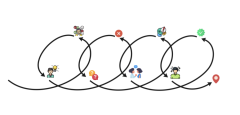Thaller, E.A. (1993). Program and Career Perceptions of Undergraduate Students Majoring in Fine Art. [Doctoral Dissertation] pp.1–343. Available at: https://files.eric.ed.gov/fulltext/ED368280.pdf [Accessed 5 Apr. 2021].
Many of the respondents were expecting to have a difficult time after graduation, trying to accomplish multiple goals of getting admitted to a Graduate Art program, becoming a practising artist, and finding a survival job.
Although many described negative past experiences in jobs that were unsuitable for them, 50% were expecting to support themselves after graduation through ”menial jobs,” ”odd jobs,” ”anything that won’t degrade” themselves, and any kind of work ”that pays a half-way decent wage.”
- Perceptions of Art and Art Courses
1.1 Art was extremely important to them. Some said Art was the most important thing in their life.
1.2 Most of the informants said that their decision to major in Art was the result of a lifelong interest or desire to study Art.
1.3 They had chosen their particular area of concentration in Art because of enjoyment in working with that medium, skill or familiarity with the medium, preference for the type of Art product created, better rapport with the professors, or preferences for the social structure in that area.
1.4 Many were actually ”generalists” because of the ”creative freedom” to mix Art media together.
2. Future Goals and Expectations
2.1 Many of them seemed unsure about the means to achieve their goals, since achieving them depended greatly on circumstances and on other people.
2.2 Their responses often indicated multiple goals, and often their Art career goals involved some Art-related way to support themselves such as teaching or museum work.
2.3 Their answers about what they were most likely to do indicated a variety of activities or a somewhat complex career path – to work and to do artwork equally.
3. Job plans and financial expectations
77% said they would consider at working a full-time Art-related job (which is sometimes hard to find).
32% indicated that they would consider a full-time job not related to Art.
55% did say they would consider working at a part-time job not related to art and working part-time at their artwork.
32% said it was likely that they would work part-time to full-time at a job not related to Art after graduation.
4. Specific suggestions by informants
4.1 having career information available in Art department offices and offering career-oriented Art courses to tell student about what to do with a major in Art and how to prepare for that.
4.2 one informant wished for a course in economics or money management specially designed for art majors.
5. Other factors
5.1 The literature showed that Art students tended to have values systems and personality traits that might make working at certain jobs more difficult. Examples were not like a job that involved a boring routine or not liking to be a ”pushy salesperson.”
5.2 The problem with taking any jobs available without analyzing and choosing jobs carefully is that they might risk getting more disillusioned by trying to do jobs for which they are unsuited in personality and values.
5.3 It is important for everyone to learn to understand their personality traits and learn to compare those to what is needed for particular jobs before they attempt them.

